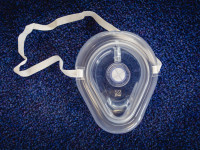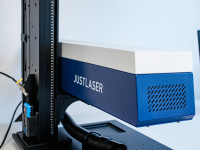What is laser marking?
Precise, permanent markings without material removal
Engraving is a special technique of laser marking that is characterized by its gentle material processing and outstanding durability. Instead of removing or engraving material, the surface is heated with pinpoint accuracy, creating a permanent color contrast. This method is particularly popular in industries where maximum precision, corrosion resistance, and material integrity are required.
How laser marking
During engraving, the surface of the metal is heated locally with a laser beam. It is crucial that the temperature is controlled so that melting or vaporization does not occur. Instead, controlled oxidation or structural change takes place in the top layer of the material.
The result is a color change caused by interference effects and the change in the thickness of the oxide layer. Different colors can be produced depending on the temperature range:
- approx. 200–250 °C → Yellow to golden tones
- approx. 250–300 °C → brown to violet tones
- approx. 300–400 °C → Blue and black tones
This layer is usually only a few micrometers thick, leaving the material surface completely smooth.
What exactly happens to the material?
1. Local heating:
The laser beam heats the metal surface precisely to temperatures between 200 °C and 500 °C, depending on the desired color and material.
2. Formation of an oxide layer:
The heat causes the metal to react with oxygen in the ambient air. This forms a thin, transparent oxide layer with a thickness in the nanometer range.
3. Light interference:
The thickness of this oxide layer determines which light waves are reflected or absorbed. This results in visible color changes (similar to the discoloration that occurs on heated stainless steel).
4. No surface damage:
Unlike engraving or deep marking, the surface remains completely intact, with no cracks or indentations.
5. Long-lasting stability:
Since the oxide layer is firmly bonded to the metal, the marking is abrasion-proof, corrosion-resistant, and resistant to many chemicals.
Advantages of laser marking
- No material removal – the surface remains completely smooth, which is particularly important for components with tight tolerances.
- High corrosion resistance – the natural passive layer of metals such as stainless steel is preserved or even reinforced.
- Excellent legibility – even on small surfaces and with intricate structures.
- Chemical and abrasion resistant – ideal for applications where the marking must withstand aggressive environmental conditions.
- Sharp results – precise laser control ensures razor-sharp lines and characters.
Typical areas of application
Occasional labeling is primarily used for metals that can form a stable protective layer through oxidation—in particular stainless steel and titanium. Common areas of application are:
- Medical technology – Labeling of surgical instruments, implants, and medical devices to meet the highest hygiene and safety standards.
- Automotive industry – Marking of components that are subject to constant stress and corrosive media.
- Aerospace – Marking of safety-related components without structural impairment.
- Food and beverage industry – Laser marking of stainless steel parts used in hygiene-critical areas.
- Electronics industry – Marking of sensitive components where a smooth surface is essential.
Technical requirements
For high-quality event labeling, a fiber laser with precisely adjustable parameters is generally used. The following factors are crucial:
- Wavelength: Usually 1,064 nm (infrared range).
- Power and pulse duration: Must be precisely adjusted to the material in order to achieve the desired color change without damage.
- Focus quality: A precise laser focus guarantees consistent color results.
Depending on the desired color tone and material composition, the laser power, processing speed, and line guidance can be adjusted.
Laser marking compared to other labeling methods
Unlike engraving or deep marking, no material is removed during temper marking. This makes it particularly suitable for applications where the surface structure must be preserved.
Compared to laser engraving, annealing marking is usually slower, but offers greater resistance to corrosion and chemical exposure. In addition, there are no recesses in which dirt or bacteria can accumulate – a decisive advantage for industries with strict hygiene standards.
Fazit
Engraving is a precise, material-friendly, and extremely durable marking method that is indispensable in highly sensitive industrial sectors. With modern laser technology, even the smallest structures can be reproduced with razor-sharp precision—without damaging the surface.
Whether in medical technology, aviation, or the food industry, this method offers maximum durability and legibility while protecting the material properties.



